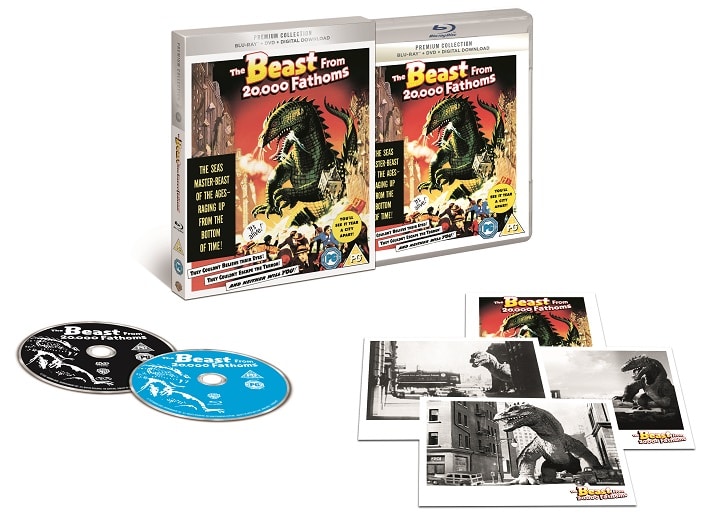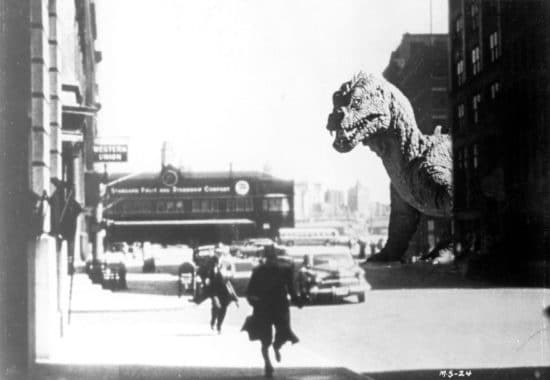 The sadly missed stop-motion animation pioneer Ray Harryhausen is one of the most unique figures in film history. The attachment of his name alone tells you basically all you need to know about the film, despite the wide variety of actors and directors he collaborated with over his decades-spanning career. While special effects may have long been a key component in popular entertainment, there has surely never been another special effects artist whose name has become so widely recognised, so synonymous with a body of work. Though he officially retired in 1981, Harryhausen’s influence has been very much in evidence in every large scale creature feature to have arrived in the years since; and that’s still very much the case in 2018 – five years after the great man passed away – with the likes of Pacific Rim: Uprising, Rampage and Jurassic World: Lost Kingdom on the horizon.
The sadly missed stop-motion animation pioneer Ray Harryhausen is one of the most unique figures in film history. The attachment of his name alone tells you basically all you need to know about the film, despite the wide variety of actors and directors he collaborated with over his decades-spanning career. While special effects may have long been a key component in popular entertainment, there has surely never been another special effects artist whose name has become so widely recognised, so synonymous with a body of work. Though he officially retired in 1981, Harryhausen’s influence has been very much in evidence in every large scale creature feature to have arrived in the years since; and that’s still very much the case in 2018 – five years after the great man passed away – with the likes of Pacific Rim: Uprising, Rampage and Jurassic World: Lost Kingdom on the horizon.
Harryhausen fans should be happy to see Warner Bros Home Entertainment honouring his memory with these new Premium Collection editions of three key titles from his body of work: one his first solo work as creator of special effects, another his last, and another from around the midway point making its first appearance on Blu-ray.
First of these is The Beast From 20,000 Fathoms, a 1953 low-budget independent production which was ultimately snapped up for distribution by Warner Bros, who quite rightly noted the presence of something special. Directed by Eugène Lourié, the film was Harryhausen’s debut feature as a solo stop-motion animator, the man alone literally being responsible for every frame of the prehistoric beast in motion. The film is also significant for helping launch Ray Bradbury in Hollywood, as the screenplay was loosely adapted from the legendary science fiction writer’s short story The Fog Horn. Given that Bradbury and Harryhausen were lifelong friends dating back to before either of them were famous, The Beast From 20,000 Fathoms has a strong sentimental value as the foremost cinematic embodiment of that celebrated friendship. On top of which, it’s long been noted as a key influence on another massively influential monster movie, Ishirō Honda’s Gojira, which arrived one year later.
All that having been said, it’s a little painful to admit that, beyond this clear historical significance, The Beast From 20,000 Fathoms really isn’t a particularly great film. While the scenes featuring the monster are undeniably iconic, these only take up a small portion of the running time, mostly in the last 20 minutes or so; beyond that, it’s little more than a deluge of arbitrary waffle, psuedo-scientific ramblings and bland subplots padding things out to an hour and a half, and all of it rather cheap and crude-looking. Sure, this is typically part of the fun with 1950s B-movies, but when Harryhausen’s work displays such genuine artistry, attention to detail and personality, it’s hard not to feel a bit let down by how amateurish everything else feels. Still, it might reasonably be argued that this set in motion the pattern for most of Harryhausen’s career; in most cases, the films overall paled in comparison to the stop-motion creations. This would most pointedly be the case in Harryhausen’s earlier days, when he was more or less a hired gun on the likes of 20 Million Miles To Earth, It Came From Beneath The Sea and Earth Vs. The Flying Saucers.
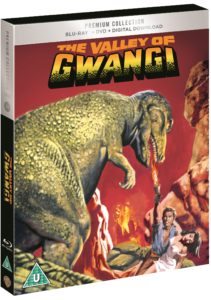
However, things had changed somewhat once The Valley of Gwangi (the title making its Blu-ray debut here) arrived in 1969. By this point, in partnership with producer Charles H Schneer, Harryhausen had more creative control of his films; since 1963’s Jason and the Argonauts (his undisputed masterpiece), he was credited as associate producer as well as creator of special effects, and the films moved away from contemporary-set spectacles of mass destruction to period fantasies which more closely reflected his own personal interests in mythology and palaeontology. Gwangi was particularly personal as it had been an unrealised project of Willis O’Brien, Harryhausen’s forebear and teacher whose legendary work on King Kong set young Ray on the path to becoming a stop-motion animator. Perhaps unsurprisingly, the plot directly echoes Kong: a band of showmen venture out into unknown territory, stumble upon a place where prehistoric creatures have survived, then unwisely decide to capture one and bring it home to sell tickets, at which point all hell breaks loose.
It’s curious to think The Valley of Gwangi arrived in the same year as Easy Rider, Midnight Cowboy, The Wild Bunch et al; this turn of the century tale of rodeo rubes crossing paths with dinosaurs will no doubt have seemed extremely quaint on release, in the face of these groundbreaking, hard-hitting works that would change the face of Hollywood. But then, that’s all part of Harryhausen’s appeal; there’s always an old-fashioned, if not timeless quality to his work which speaks to us on a childlike, fantastical level. As such, there’s an overriding sense of innocence to it all, even when proceedings get comparatively macabre. Gwangi certainly has its grim moments, from its opening scene of an exhausted, blood-spattered man staggering out of the desert, to the fairly gruesome scenes later on in which the dinosaur of the title takes bites out of elephants, horses and other dinosaurs. (Still rated U, though.)
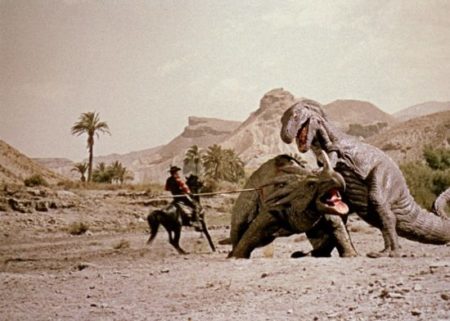 Not unlike The Beast From 20,000 Fathoms, The Valley of Gwangi is another film that’s notable primarily for Harryhausen’s effects, and rather less interesting when his creations are not on screen. In this case, though, the creature action is so good and so well spread out over the running time that it’s easy to ignore the filler material. Even so, there’s an undeniable novelty value to a story in which cowboys meet dinosaurs; indeed, for the first 25 minutes or so you’d be forgiven for thinking it was nothing more than a straight western, until the bizarre miniature horse makes its first appearance. James Franciscus (best known for looking a bit like Charlton Heston, and appearing in Beneath the Planet of the Apes) makes for a reasonably engaging leading man, although it perhaps doesn’t help that female lead Gila Golan has so obviously had all her dialogue overdubbed by another actress. Again, though, we might just as easily embrace this as part of the B-movie charm.
Not unlike The Beast From 20,000 Fathoms, The Valley of Gwangi is another film that’s notable primarily for Harryhausen’s effects, and rather less interesting when his creations are not on screen. In this case, though, the creature action is so good and so well spread out over the running time that it’s easy to ignore the filler material. Even so, there’s an undeniable novelty value to a story in which cowboys meet dinosaurs; indeed, for the first 25 minutes or so you’d be forgiven for thinking it was nothing more than a straight western, until the bizarre miniature horse makes its first appearance. James Franciscus (best known for looking a bit like Charlton Heston, and appearing in Beneath the Planet of the Apes) makes for a reasonably engaging leading man, although it perhaps doesn’t help that female lead Gila Golan has so obviously had all her dialogue overdubbed by another actress. Again, though, we might just as easily embrace this as part of the B-movie charm.
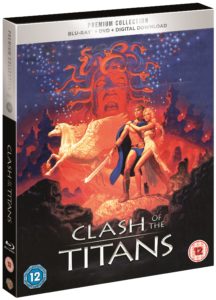 Topping off this trio of re-releases is Clash of the Titans. Originally an MGM-UA release in 1981, this was Ray Harryhausen’s final feature as creator of special effects, and sought to revisit the success of Jason and the Argonauts by again venturing into Greek mythology territory, this time with the story of Perseus, Andromeda and Medusa. Though it boasts the starriest cast ever to assemble for a Harryhausen movie – among them Laurence Olivier, Maggie Smith and Burgess Meredith – it isn’t quite so successful as Jason was. Even so, it’s a charming bit of fun whose many obvious flaws are very easy to overlook.
Topping off this trio of re-releases is Clash of the Titans. Originally an MGM-UA release in 1981, this was Ray Harryhausen’s final feature as creator of special effects, and sought to revisit the success of Jason and the Argonauts by again venturing into Greek mythology territory, this time with the story of Perseus, Andromeda and Medusa. Though it boasts the starriest cast ever to assemble for a Harryhausen movie – among them Laurence Olivier, Maggie Smith and Burgess Meredith – it isn’t quite so successful as Jason was. Even so, it’s a charming bit of fun whose many obvious flaws are very easy to overlook.
It’s not too surprising that Harryhausen chose to bow out with Titans. Tonally, it’s very much in-keeping with his earlier mythic movies (including the two Sinbad movies of the 1970s). However, with the rise of Industrial Light & Magic, special effects had taken significant leaps forward, and for all its character and personality, the stop-motion approach was undeniably looking a bit too dated to keep up. This antiquated quality extends beyond the effects work alone. The film overall has an awkward, overly twee feel, with much of the cast, even the illustrious Olivier and Smith, seeming ill at ease. Curious, then, that in some parts the film endeavours toward a more mature appeal, with some brief (though non-sexualised) female nudity, and a slightly higher gore quota. Strange also to think that things might have gone even further, as Beverly Cross’s original script called for Andromeda to be naked when offered up to the Kraken, whilst that famed beast would also have bloodily torn apart Perseus’ noble winged steed Pegasus. While my more salacious side can’t deny curiosity about what such scenes would have looked like, I’m sure it’s for the best they were rewritten; such extreme spectacles might have been commonplace in the Greek tales, but it’s hard to envisage them working in a film so otherwise family friendly as this.
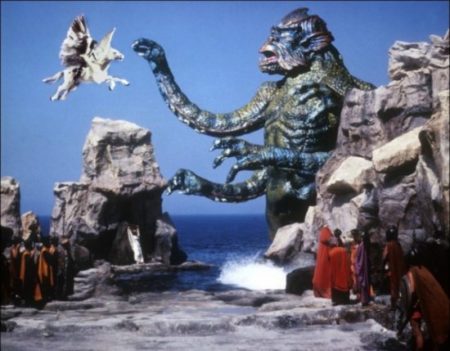
The Warner Bros Premium Collection has produced some very nice editions of old favourites that will sit handsomely on any fan’s shelf, and these three new releases are no exception. The films themselves look great and are well packaged, with a small set of collector’s cards in each box. The discs are fairly light on extras, though, mostly limited to one or two short interview featurettes with Harryhausen, all of which date back to earlier DVD editions; in the case of Clash of the Titans, both the DVD and Blu-ray appear to be direct re-releases of the edition which coincided with the 2010 remake, as the disc opens with a short featurette advertising that film. However, there’s a particular appeal to the extras on The Beast From 20,000 Fathoms, as it features a side-by-side interview of Harryhausen and Ray Bradbury reflecting on their lifelong friendship, and how that film changed their lives. Heart-warming stuff; as, indeed, can be said of all Ray Harryhausen’s work.
The Beast From 20,000 Fathoms, The Valley of Gwangi and Clash of the Titans will be released in dual format DVD & Blu-ray on 26th February as part of Warner Bros Home Entertainment’s Premium Collection, available exclusively at HMV.
